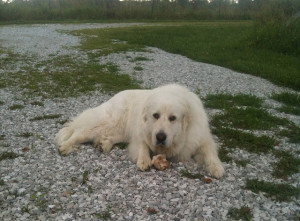At first, dog owners find it cute when their young pup suddenly acts “jealous” when another person approaches you, or they do their little puppy growl when the other dog in the house approaches their food bowl. But fast forward and the dog is two years old, being turned into the shelter because it has just bitten the youngest family member.
Countless dogs are brought into shelters every year for what turns out to be resource guarding – the owners having had no clue about why their dog acted that way.
What is Resource Guarding?
Resource guarding is a serious behavior issue where you dog guards whatever “resource” she deems important. It can show up in puppies, I’ve seen it as young as three months of age.

Signs of guarding include, but are not limited to: stiffening, showing their teeth, growling, snapping, eating faster, wagging their tail faster, putting items between their paws with head over it, etc. Depending on the situation, your dog may show one or all of these.
Common things guarded by dogs:
- Food
- Chew bones
- Toys
- Empty food dish
- Water bowl
- People they know
- Areas of the house such as couch, human bed, etc.
- Personal space around the dog
- Dog bed
- Leash
Really, a dog can guard ANYTHING he sees as a precious item.
Important Facts
Before doing anything with a resource guarder, it is critical to understand these facts:
- It IS genetic – you can’t get rid of it completely or “change your dog’s brain”
- It will get worse – your puppy will not “get over it,” “grow out of it,” “or get used to you taking her stuff”
- It doesn’t matter how much you think your dog loves you – if you push him, he will bite you
- Other dogs will not just “respect” your dog and not take whatever they are guarding – assuming this will lead to vet bills
- Once a guarder, always a guarder, regardless of the amount of training put in
- If they guard one thing, they may guard other items/spaces
Related: A Comprehensive New Puppy Checklist for First-Time Pet Owners
Training
So now that you are totally freaked out, take a deep breath. It is possible to live completely happily with a resource guarding. In fact, I have TWO food and bone guarders at home that co-exist just fine. It’s all about training and management.
There are few cues that are a MUST for resource guarders:
- Drop it
- Leave it
- Easy (take the treat, toy, bone, nicely)
- Stay (so they won’t run toward whatever it is they want to guard)
- Sit for whatever it is she wants (this helps with self-control and learning to not just take whatever they want but to “ask” for it)
Drop is a must so that you can take away whatever it is that your guarder has, safely.
Leave it is excellent for if you see your guarder going toward something he will guard and you want to avoid the scenario. It also works great if you see another dog approaching the guarder. Tell the other dog to “leave it” to avoid a confrontation.
Also, teach your dog to never “snap” for anything (the Easy cue). To do this, have a cookie or toy in your hand and move it toward your dog. If your dog moves at all toward the item, withdraw the item for a few seconds, then try again. Continue until your dog does not move toward the item, but waits until you bring it all the way to them (source: Carolyn Wilki).
NOTE: these are advanced levels of these cues that take time to reach. Be sure to work with a certified dog trainer.
Management Tips
These are things you do daily while your dog is in training and to avoid any accidents. Some you may have to always do and others you may be able to fade as your dog’s training gets better. The MOST IMPORTANT THING is to get a good dog trainer as soon as possible.
- Always have something to trade your dog with if you have to take something away from her (for example, cookie for toy)
- Always separate your animals while they eat
- Put the food in the bowl, set the bowl down, and then let your dog in to eat
- Wait until your dog is completely down eating and walks away from the dish. Since some will guard the dish, wait until they are out of the room before picking up the dish
- Do not allow your dog to “possess” anything. If she guards the couch or bed, those areas become off-limits. If she guards a bone from someone, take it away as soon as you safely can.
- Have a sign up to remind guests and strangers coming into your home, ESPECIALLY if the dog guards you
- Put your dog in a kennel or another room when guests are over if he guards you or space in your home
- Watch children and make sure they are not “teasing” your dog by trying to take away toys or showing them a toy but then not giving it to them. This is how bites happen.
 Toledo, United States.
Toledo, United States.